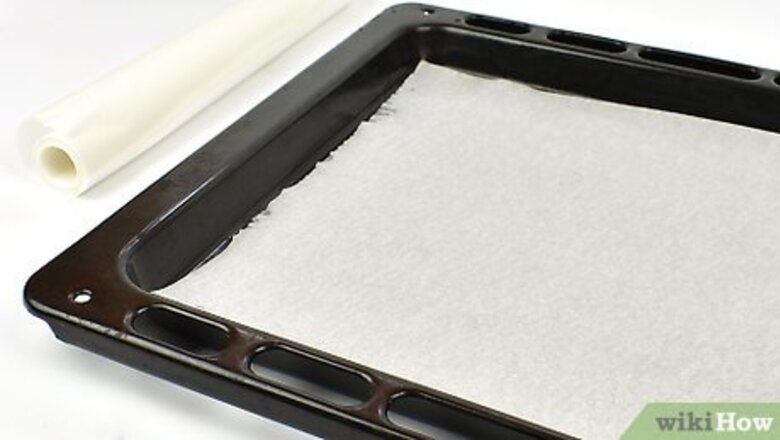
views
Baking Dry Kibble
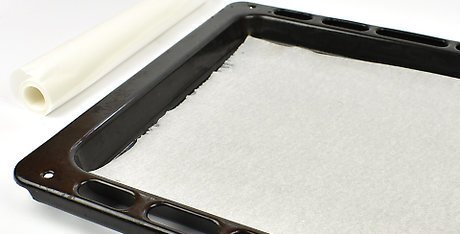
Preheat your oven to 350 °F (177 °C) and prepare a baking sheet. It’s best to not use cooking oil or butter to grease the sheet so that you don’t add extra fat to your cat’s diet. Instead, cut out a piece of parchment paper that will fit the bottom of the pan. Set the sheet to the side so it’s ready to go once the dough is done. If you’re using small baking sheets that are 18 by 13 inches (46 by 33 cm) or smaller, prepare 2 of them to make sure there is enough room for all the kibble to bake. Otherwise, you might have to cook the kibble in batches.
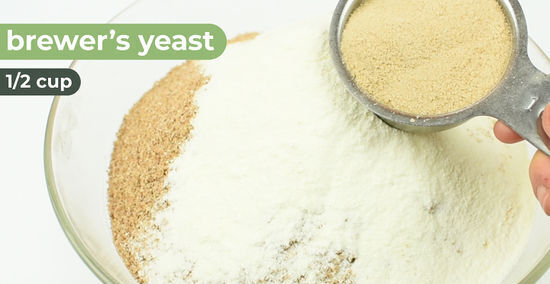
Whisk together the dry ingredients in a large mixing bowl. Measure out 1 cup (150 grams) of cornmeal, 2 cups (210 grams) of soy flour, 3 cups (340 grams) of whole wheat flour, 1 cup (115 grams) of wheat germ, 1 cup (125 grams) of fat-free dry milk, and 1/2 cup (68 grams) of brewer’s yeast into a very large mixing bowl. Use a whisk or wooden spoon to combine all of the dry ingredients together. Keep in mind that you’ll want to supplement your kitty’s dry kibble with wet or raw food 2 to 3 times a week to keep it happy and healthy. Dry kibble doesn’t contain all the essential nutrients that your cat needs, but it’s okay to use as long as you give your cat some variety throughout the week.

Smash the mackerel and oils together in a small bowl. Put 15 ounces (430 g) of canned mackerel, 5 tablespoons (74 mL) of vegetable oil, and 1 tablespoon (15 mL) of cod liver oil into a small bowl. Use a fork to whisk and mash the ingredients together. It’s okay if the mackerel is still in small bits when you’re finished. If you don’t have mackerel, you could also use sardines or anchovies. These fish provide calcium and phosphorous, both of which your cat needs. The vegetable and cod liver oils provide much needed Omega-6 fatty acids that your cat can only get from its diet.

Measure 2 cups (470 mL) of water into the bowl with the dry ingredients. Combine the water and the dry ingredients with a large spoon until it gets too heavy and thick to handle. When that happens, you will need to switch to mixing it by hand. Gather the dough into a ball and then push down on it while it’s in the bowl. Repeat this gathering and pushing motion, using as much pressure as you need to really work all the ingredients together. Make sure to wash your hands before putting them into the dough. To clean up after kneading the dough, scoop out a small handful of flour with a spoon or measuring cup and rub it into your hands (never dip dough-covered hands directly into the storage container). This should absorb the moisture from the dough and cause it to separate from your skin. After you’ve gotten most of the dough off, wash your hands with soap and water.

Add the fish and oil mixture to the dough. Once the water and dry ingredients have mostly combined, go ahead and pour the mackerel and oil over the top of the dough. Start mixing with a spoon, and if that doesn’t work, switch back to mixing it by hand. The dough will be really thick and you may be tempted to add more water, but remember that you are making hard, dry kibble—the dough needs to be a bit rough in order to bake properly in the oven.
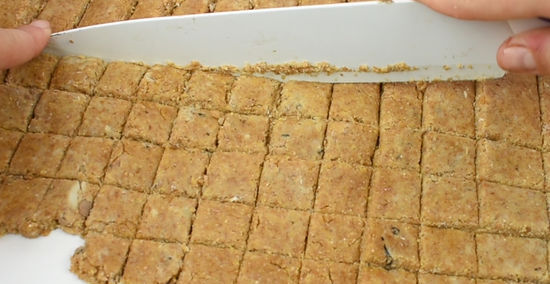
Roll out the dough and cut it into small ⁄4 inch (0.64 cm) squares. Put the dough between 2 sheets of parchment paper and use a rolling pin to roll it out so it’s about ⁄4 inch (0.64 cm) thick. Remove the top piece of parchment paper, and use a long, thin knife to cut the dough into small ⁄4 inch (0.64 cm) squares. Avoid making the squares too big! They need to be small enough that your cat can safely eat them.

Bake the kibble for 20 to 25 minutes, flipping it every 5 to 10 minutes. Transfer your cut kibble to your prepared baking tray and put it into the oven, which should by now be preheated to 350 °F (177 °C). In all, it should take 20 to 25 minutes for the kibble to cook through. Try to take the kibble out every 5 to 10 minutes to toss it around so that all sides get evenly browned. Be careful when taking things in and out of the oven. Always use an oven mitt or something similar to protect your hands.

Refrigerate the kibble in an air-tight container for up to 3 weeks. Once the kibble is done baking, let it cool on the tray for 10 to 15 minutes. Once it has cooled down, go ahead and transfer it to an airtight container. Keep the kibble in the fridge, and give your kitty 1/2 cup (75 grams) twice a day, or more or less depending on its dietary needs. If your cat prefers wet food, you could always add 2 to 3 tablespoons (30 to 44 mL) of chicken gravy overtop of its food.
Making a Chicken and Vegetable Medley

Broil or bake 1 chicken breast, or enough to make 1 cup (125 grams). Make sure the chicken is cooked through and measures 165 °F (74 °C) in the center (use a meat thermometer to double-check the temperature). You’ll be adding the chicken to a blender, so you can leave the chicken breast whole, or you could cut it up into smaller pieces to make it easier to blend. If you can, use organic chicken that doesn’t have any additional saline solution or hormones added to it. You can also use small game, like rabbit or hen, if you don’t have chicken. Don’t use the microwave to cook the chicken. The heat can cook the meat unevenly and can also kill off those essential proteins that your cat needs.

Steam 1/4 cup (40 grams) of broccoli and 1/4 cup (37.5 grams) of carrots. This you can do in the microwave if you prefer, or use a steaming basket on the stove. Steaming the vegetables is essential to softening them up enough to mix in with the chicken; otherwise, your cat might pick around the vegetables to just get at the meat. Broccoli and carrots provide your cat with Vitamin A, Vitamin C, potassium, fiber, calcium, and beta-carotenes. They’re great for the heart, colon, bones, and eyes. Don’t season the vegetables with salt or pepper. If you want to, you could add 1 tablespoon (15 mL) of fish oil to add some extra flavor and to provide your cat with healthy Omega-6 fatty acids.
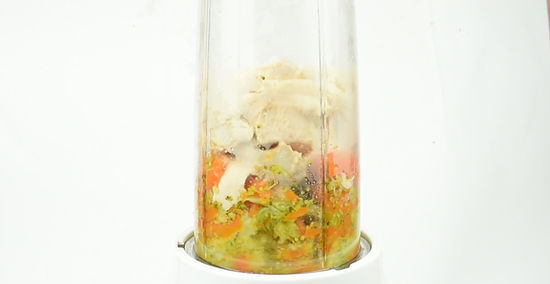
Blend the vegetables and chicken together in a food processor. You can use a grinder, a blender, or a food processor for this step, just as long as the meat and vegetables fully break down and combine together. You can blend the food while it’s hot or wait until it has cooled down. Chicken is a great source of protein, which is essential to your cat’s health. It helps their muscles stay strong and gives them the energy they need to function on a day-to-day basis. Always use a clean food processor or other apparatus to make your cat’s food to avoid contamination.

Add in chicken broth as needed to give the food a smooth consistency. At most, you shouldn’t need more than 3 to 4 tablespoons (44 to 59 mL) of chicken broth because there should be some moisture coming from the vegetables. Add enough so that the food is smooth, but not so much that it turns into a liquid. You could substitute the chicken broth for chicken gravy to give the food a more robust flavor.
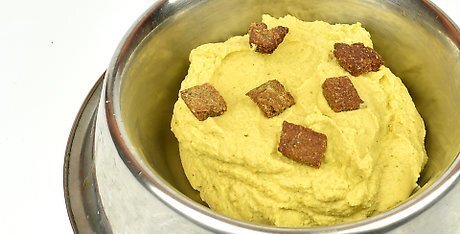
Feed your cat after the food has cooled down completely. Avoid giving your cat hot food, as this could upset its stomach. Most cats eat about 300 calories per day, so your cat can most likely eat the entire batch of chicken and vegetables and still not exceed its calorie allotment for the day, but check with your vet to make sure you’re not under- or over-feeding your feline friend. You can feed your cat this type of food on a daily basis, but try interspersing it with other recipes or dry food several times a week to provide some variety in your cat’s diet. Store leftover food in the fridge for up to 3 days in an airtight container. If food is left out at room temperature for more than 2 to 3 hours, get rid of it.




















Comments
0 comment